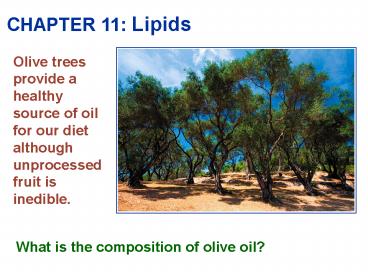Biochemistry: A Short Course - PowerPoint PPT Presentation
1 / 18
Title:
Biochemistry: A Short Course
Description:
CHAPTER 11: Lipids Olive trees provide a healthy source of oil for our diet although unprocessed fruit is inedible. What is the composition of olive oil? – PowerPoint PPT presentation
Number of Views:207
Avg rating:3.0/5.0
Title: Biochemistry: A Short Course
1
CHAPTER 11 Lipids
Olive trees provide a healthy source of oil for
our diet although unprocessed fruit is inedible.
What is the composition of olive oil?
2
Lipids
Migrate over-water 2,400 miles
Water insoluble (hydrophobic) Non-polymeric
structure Energy storage, membrane constituent,
hormone signaling
3
I. Fatty Acids Fuel Membrane Building Blocks
Hydrocarbon with carboxylic acid head
group Highly reduced carbon source Ionized at
neutral pH (-ate not -ic acid form)
Soap fatty acid salt
Which fatty acid is more reduced? What makes
soap a good cleaner?
4
Fatty Acid Conventions
The positions of double bonds are indicated with
the symbol ?, with the first atom of the double
bond indicated by superscript number. ?9
indicates a double bond between carbon atoms 9
and 10. Because fatty acids are ionized at
physiological pH, they are usually referred to as
their carboxylate form, rather than the unionized
acid.
5
Naturally Occurring Animal Fatty Acids Common
and Systemic Names
6
(No Transcript)
7
Melting Point and Membrane Fluidity
Shorter chain length lowers melting point cis
Double bond lowers melting point Unsaturated
fatty acids (oils) lower melting point versus
saturated fatty acids (solid)
Predict the oil composition from palm versus
canola plants.
8
Health Versus Fat Quantity and Quality
Trans fats correlated with high blood
cholesterol/cardiovascular disease
(inflammation?) Cis polyunsaturated fatty acids
essential for the diet (inhibit blood clotting,
reduce heart attack risk) Vegetable oil
(linolenate) Shell fish/cold water fish
(EPA/DHA)
9
II. Triacylglycerol in Energy Storage
Anhydrous fat /gram stores 6x energy of hydrated
glycogen Triacylglycerol storage site adipose
tissue Sugar storage 18 hrs triacylglycerol
storage several weeks
10
Phospholipids, Glycolipids and Steroids
What do these lipids have in common? How do
these lipids differ?
11
III. Phospholipids Major Class of Membrane Lipids
Phosphatidate key intermediate in
phosphoglyceride biosynthesis and membranes
12
Common Membrane Phosphoglycerides
What does the color coding for green, blue and
pink represent?
13
Membrane Sphingolipids
Amino alcohol backbone sphingosine Sphingomyel
in sphingosine with a fatty acid amide linkage
and choline abundant in nerve cell membranes
trans double bond
Cerebroside sphingosine with one sugar residue
is the simplest type of glycolipid
14
IV. Glycolipids
Gangliosides sphingosine with multiple sugar
residues Sugars are extracellular A, B and O
blood typing
Multiple sugar units
15
V. Steroids
Tetracyclic ring structure (3 cyclohexane fused
with cyclopentane) Facilitate lipid
digestion Membrane fluidity buffer
How does cholesterol orientate in the membrane?
16
Lipoproteins
Protein attachments to the surface of a membrane
17
Membrane Component from a High-Temperature
Organism
What are the chemical differences in this lipid
from standard membrane lipids? What impact do
these alterations have on lipid behavior?
18
Chapter 11 Problems 1-19 Workbook page 58 2-9
due April 2































